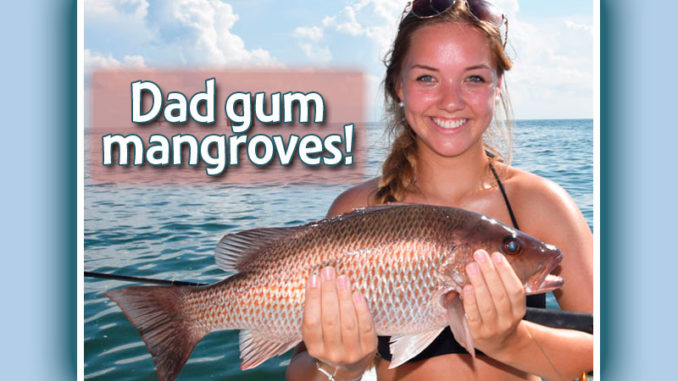
This Lafitte guide relaxes by heading out of Grand Isle to catch mangrove snapper, one of the most-persnickety fish in the Gulf. Here’s how he catches regular multi-person limits.
Since my son was onboard, the worst expletive I could muster was a gruff, “Dad gum it!”
I’m normally slow to anger and even slower to speak, but this was the third fish I had lost in less than 10 minutes.
“You can’t get frustrated, Chris,” Capt. Lane Zimmer told me as he grabbed my line to tie on another hook. “That’s part of fishing this way. You’re going to lose fish.
“That’s why I bring a bunch of hooks and a bunch of bait.”
My main problem was that many of the mangrove snapper that inhaled my pieces of Spanish sardines made beelines to the barnacle-encrusted legs of the oil rig.
I never would have thought 10-pound fish could be so hard to turn.
Because I could not turn these three, our 50-fish limit was in serious jeopardy. We only needed six to wrap it up, and I had just lost half of that.
Thankfully, the other anglers on board were much more skilled at catching mangroves than I am and had bumped us three fish closer.
But to hear Zimmer — who guides for redfish and speckled trout (504-415-8006) out of Lafitte and fishes mangrove snapper only for fun — explain it, the fact that we were staring at 47 mangroves on ice was an accomplishment in and of itself.
It’s hard to fool these finicky fish
“These are finicky, finicky fish,” he said. “They seem like they would be so easy to catch, but they’re probably one of the most difficult to catch.”
Mangrove snapper seem so easy because anglers can literally pull up to a rig and watch them swarming after a few bits of chum.
But watching and catching are two entirely different things.
My son Matthew and I had met up with Zimmer, his brother Joey Zimmer and their cousin TJ Roussell to see if we might be able to scare up a few lemonfish.
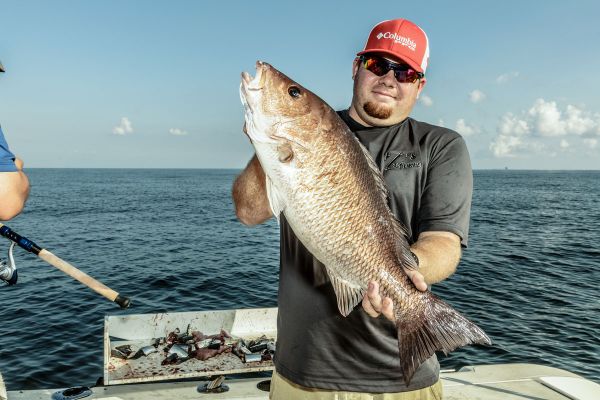
Lane Zimmer knew I was not a huge fan of offshore fishing, so he assured me we would be in sight of the Grand Isle water tower and Port Fourchon all day long.
“We don’t have to go far,” he assured me. “The only issue we might have is that we’re fishing the Monday right after the Grand Isle Tarpon Rodeo.
“I would imagine these close rigs have seen a boat or two the last couple of days.”
After checking to see which would be the best way to set up on the first rig, Zimmer concluded that the wind and the tide were canceling each other out; therefore, he wound up hooking to the rig and leaving one motor in reverse to keep us away from the structure.
Chumming the right way
Joey Zimmer, who owns Z’s Tackle in Lutcher, immediately unboxed some frozen Spanish sardines we had picked up at Grand Isle’s Bridge Side Marina only minutes before and started tossing cut-up pieces into the water at the base of the rig.
I watched the pieces of chum slowly disappear — each one gently washing away from the rig in the slowly moving tide.
Lane Zimmer threaded a piece of sardine onto my son’s hook and instructed him on how and where to throw it.
“Pull in your slack,” I told him upon noticing the giant bow in his line and the pile of line floating on top of the water.
“No, don’t pull up your slack,” Zimmer countered. “That’s the last thing you want to do with these mangroves. You want your bait to look exactly like the chum we just threw our.
“You pull up your slack and your bait is going to look different enough that these fish won’t touch it.”
I’ve heard some fishing stories before, but was Zimmer really indicating that mangrove snapper could tell a piece of chum on a hook was different from a piece of chum not on a hook?
“Yes, that’s exactly what I’m saying,” he explained. “These are some of the smartest fish in the Gulf of Mexico. You don’t fish for them the way you want to fish; you fish for them the way they want you to fish.”
For Zimmer, fishing for mangroves the way they want him to fish means doing everything in his power to make the Spanish sardine on his hook look exactly like the Spanish sardine floating freely in the water.
Apparently, this is the difference between showing up at the dock with 50 mangroves rather than just five fish.
How to outsmart the smartest fish in the Gulf
“Limiting out on mangroves with five people on the boat — you’ve got to know what you’re doing to do that,” Zimmer said as he pitched his bait toward the rig. “The guys that know what to do? Yes, they’ll catch them.
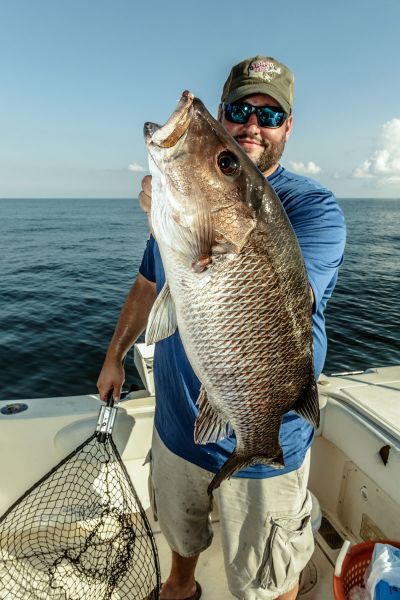
“But a lot of boats with five guys might get lucky to catch 20 or 30 fish. And the guys that come out here with heavy tackle and fish the bottom will luck up and catch a handful.”
The rigs we were fishing were hardly seven miles from Grand Isle — Zimmer called them the Grand Isle 22 Block. Depending on which structure we fished, water depth ranged from 50 to 60 feet.
“They’re definitely not a secret,” Zimmer said. “Anybody with a good bay boat can run out here on a calm day and get in on the action. That’s why I say these are some of the smartest mangrove snapper in all of Louisiana: The fishing pressure is high enough they learn how to not get caught.”
Gear
Whereas many anglers making the short run to these rigs might bring along 7/0 hooks, 80-pound leaders, swivels and big weights, Zimmer packs 4/0 hooks, 40-pound leader line, no swivels and no weights.
Anglers fishing the big, heavy gear might wind up catching a few red snapper, a lemonfish or two, bulls reds, black drum and some sharks, but any mangrove snapper they catch will be out of sheer luck.
“Mangroves can see all that stuff,” Zimmer said. “And they’re smart enough to figure out which piece of chum has a hook in it. If they see your big hook, swivel or line, they won’t hit it.
“If they can tell your piece of chum isn’t falling like all the rest, they won’t hit it.”
Rig fishing
Ideally, Zimmer likes to hook up to a rig on the downcurrent side and toss a few handfuls of chum under the edge of the rig. As the current washes the chum away from the base of the rig, mangroves follow it out to the point where they are easily spotted under the water.
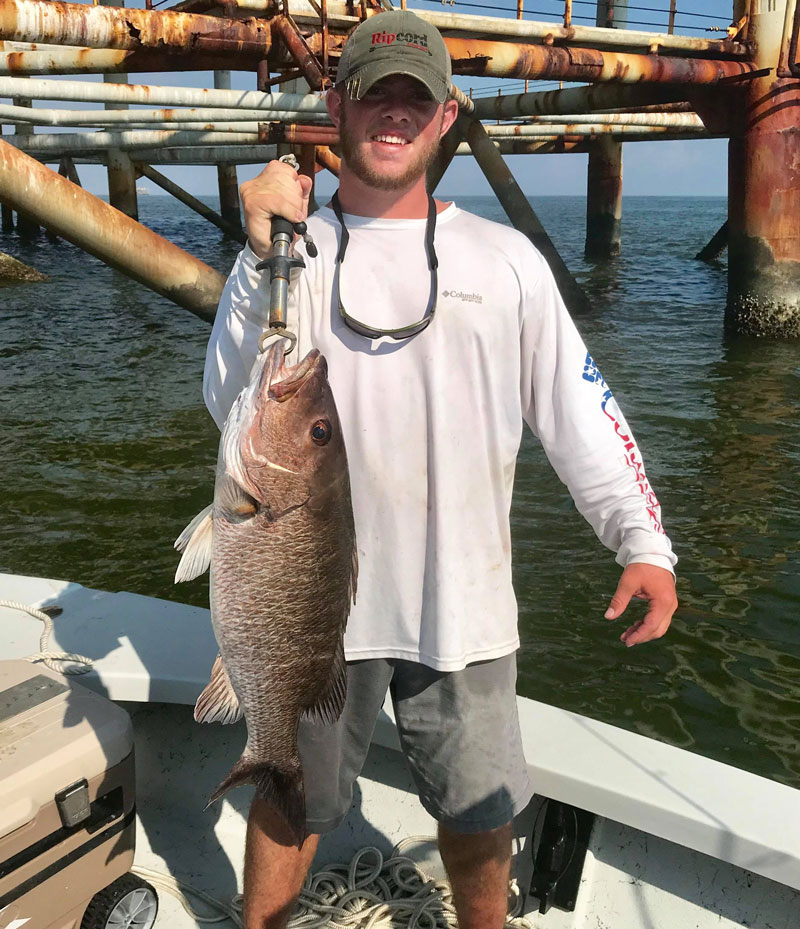
Then, because his knot might tend to catch on the last rod eye, Zimmer pulls out enough line to clear the connection from the eye and hand tosses his Spanish sardine toward the rig.
“That gives your bait enough time to float down with the chum,” Zimmer explained. “It’s going to fall a little bit faster no matter what you do, so I try to make it kind of pendulum back away from the rig so that it comes down right in the middle of the frenzy where they’re feeding on the chum I just threw in the water.”
This scenario partly played out as we bounced around from rig to rig.
For some reason, the mangroves were deeper than Zimmer expected them to be, and we never really saw the big schools of them feeding on the chum. They were there, but we had to really wait them out and let our bait fall way out of sight.
“It’s probably a combination of the pressure from the Tarpon Rodeo and the water color,” he explained as we stopped at one last rig to try to finish out our limit with six more mangroves.
Dirty water
“What you’ve got to realize is that when it’s dirty like this, there’s a line down there that separates the dirty water on the surface from the clean underneath. That’s where these fish like to hang out, and it must be a little deeper today than it normally is — must be down around 15 feet today.”
On this last rig, the perfect scenario played out. A giant school of mangroves came out from under the rig to feed on the chum. The Zimmer brothers and Roussell landed three quick fish before a curious lemonfish demanded our attention.
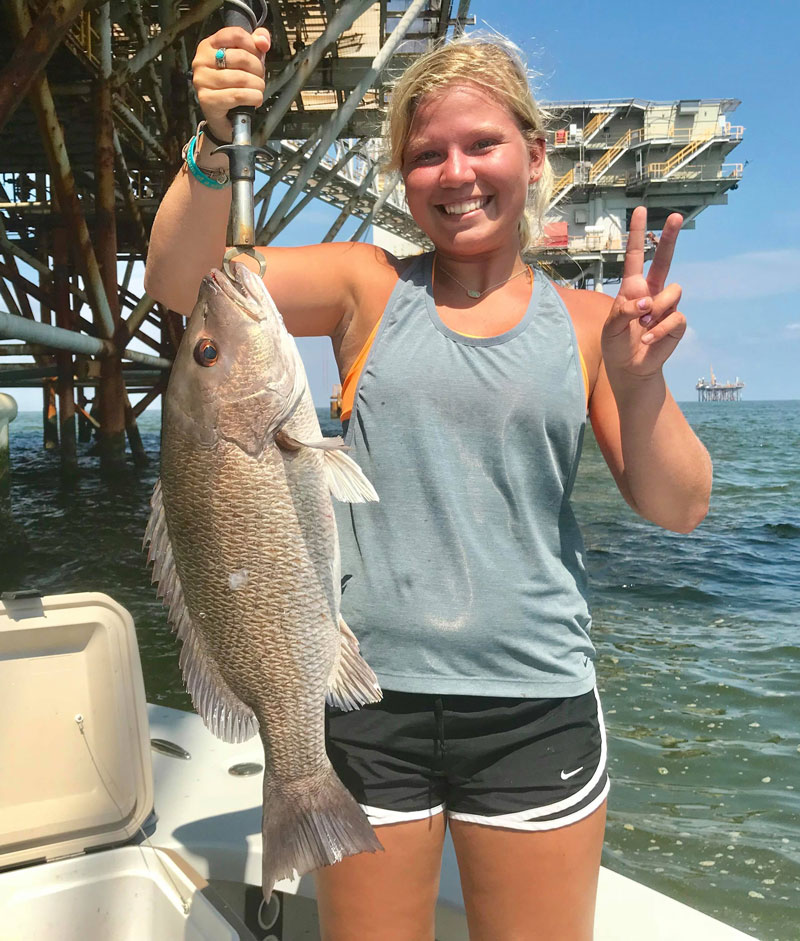
After playing with the lemonfish to keep it excited, Roussell hooked and fought it a few short minutes before it broke off.
Down but not out, we returned our attention to catching three more mangrove snapper.
“I think they’ve figured us out,” Zimmer lamented as he watched me lose three fish while the rest of the mangroves turned their noses up at our baits. “You might not believe this, but after watching a few of their buddies getting jerked out of the water, they’re not going to eat anything that looks different than the chum we’re throwing out.”
That’s about the time Zimmer scolded me about getting frustrated.
“(If y)ou fish like this you’ve got to have some patience, and you can’t get frustrated,” he said. “We went through almost 50 hooks today, and we caught almost 50 fish — only three short our five-man limit.”
Yep — three short of our five-man, 50-fish limit.
Dad gum it!
How to catch lemonfish while mangrove snapper fishing
When fishing for mangroves, Capt. Lane Zimmer always keeps a few rods at the ready in case he spots a curious lemonfish cruising the surface.
“Take that last rig we fished today,” he said. “That was a perfect example of how this typically plays out. We got the mangroves fired up with the chum, and all that activity got that lemonfish fired up, too.
“He wanted to come see what all the fuss was about.”
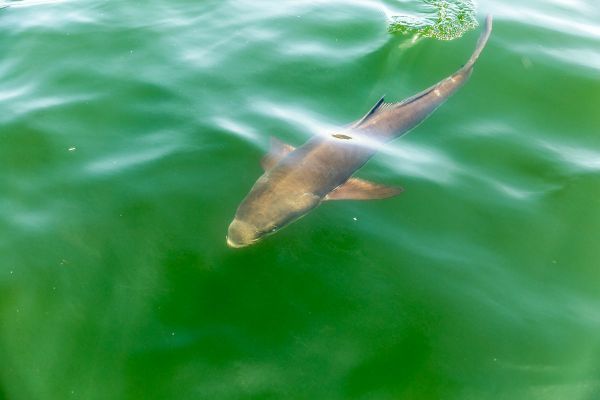
Notoriously curious, lemonfish can be anywhere from the bottom to the surface, and they are known for coming up to investigate any strange noises or commotion on top of the water.
“When we spot one, everything stops and we focus entirely on the lemonfish,” Zimmer said. “We try to keep him excited by throwing more chum out because once he loses interest he’s gone.”
Zimmer said a lemonfish at the surface will eat a bait put in front of it 99 out of 100 times.
“We lost that fish because we hooked it on a mangrove rod, which had the drag locked down,” Zimmer explained. “Had we hooked it on one of the rods I keep ready for lemonfish, we would have probably landed it because the drags were set right.”
Zimmer’s lemonfish rods are typically spooled up with 80-pound fluorocarbon line and a big 5/0 hook on a conventional reel rather than a spinning reel. And instead of a piece of cut bait he’ll hook on an entire Spanish sardine.
Terminal tackle tips for more mangroves
Capt. Lane Zimmer has battled mangrove snapper enough to have seen all the highs and lows that come with going after these smart fish inhabiting oil rigs close to Louisiana’s coastline.
The most-important lessen he’s learned is that to consistently fool mangroves he has to make his presentation as invisible as possible.
“I’ve come up with a system that works for me through a lot of trail and error,” Zimmer said. “And the way I’ve learned what works is paying attention to what doesn’t work.”
Hooks

Case in point: He started out fishing big hooks before realizing he had to change to smaller hooks. Then he fished thin-wire hooks before learning that he had to fish thicker hooks.
“The two I use now are the 2/0 Gamakatsu circle octopus hook and the 3/0 Mustad UltraPoint Demon Perfect 1x circle hook,” Zimmer said. “I’ve gone through so many over the years — some not as strong at that same size that straighten to the point they look like they’ve never even been bent.
“These two do the job, though.”
Line
As for line, Zimmer spools his reels with heavy braided line, but he always ties about a 5-foot length of 40-pound fluorocarbon leader using either a uni-to-uni or an Albright knot connection.
“I start with 40-pound (leader) and adjust from there,” Zimmer said. “If they don’t hit 40-pound, I know I’ve got to go smaller. If I think it’s dirty enough for me to go up to 50-pound, I will — but only if they keep biting.
“The fish will tell you what they want.”

Zimmer uses fluorocarbon because it has as close to the same light refractive index as water, which means it virtually disappears under water.
And believing mangroves can spot coils of line in the water, he ties one end of his leader to a boat cleat and jerks on it to straighten it out.
But even all of this isn’t enough to satisfy Zimmer. That’s why he takes the time to hide his hooks inside pieces of Spanish sardine. Rather than thread his hook straight through the eyes, he’ll run it through the eyes and then bury it inside a little slot he makes in the meat.
“By the time I’m done, I’m fishing a bait that is as natural as I can make it,” Zimmer said. “And that’s the only way I’ve learned to consistently catch these finicky mangrove snapper.”